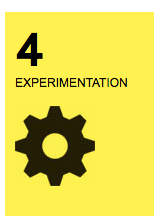Sometimes it's hard to know where to start or what is possible while sitting in our 30 year old classrooms of desks in rows, fluorescent lighting, and beige paint. To be fair, anyone would struggle for imagination in that environment. Therefore we find it useful to preview the process with teachers before going full on into the Design process which takes a lot of time, is an intensive process, and is often unfamiliar to teachers.
The Edutopia video series below showcases a relatable middle school classroom which is transformed over the weekend with the help of a team of designers and community volunteers, all for $1000. It’s important to understand that a classroom redesign is not going to other schools or on Pinterest to see what other spaces look like and what solution you can import into yours. We are redesigning an experience and the space is a resource/tool to enhance that. Therefore the important thing we need understand is the current reality and future preferred state.
Critical to the redesign of a space is the understanding and execution of the Design process. While watching this video, do so through the lens of a designer and watch for the various stages of the process.
Courtesy of the d:School at Stanford
Discovery: Gaining insight into the user experience, divergent in nature. Central to this is gaining empathy for all members of the learning community of that space, students and teachers. We are redesigning a space to reflect the learning aspirations for learnings in 2018. The 19th century classrooms were build for direct teaching and classroom management and paid little or no attention to the student experience or how these environments made them feel.
Interpretation: Grouping the data from Discovery into Drivers and Constraints, convergent in nature. In this sample the drivers of collaboration, movement and ambience are translated into spatial concepts as drivers to support learning and you can see the impact immediately.
Ideation: Bringing the drivers to life and creatively solving for the constraints, divergent. In this example I like how the Christian and Melanie anchored the Solution Session to collaboration, comfort and movement as well as aspects such as storage, entry and furniture, each with a unique provocations. As result their ideas are directly focused on solving for the experience.
Prototyping: This is a tough aspect for schools to be able to really dive into. The goal is to bring to life various installations for the drivers and constraints but most schools do not have the resources to bring in various pieces of furniture nor have a construction crew to continually modify the space. Hence the importance of experience and low fidelity installations. The space needs be a living space, a space in progress, responsive to the needs of the learning experience.
Evolution: You can see immediately the impact the space has on the faces of the students. Capturing those initial reactions is important. If they reflect the your drivers, you are on the right track. The initial buzz will wear off and a more indepth evaluation is essential but the reveal reaction is what you strive to replicate.
Hopefully this gives you insight into the what is possible and the process necessary to redesign a learning space. The more you commit to the process, the more of a positive impact the space will have on the learning experience. Redesigning spaces is not going through the Ikea catalog with the teacher. It’s spending the time in the desk with the students, facilitating group empathy activities, listening to understand, and including the community in the process to create the optimal climate for your community’s learning aspirations. Think climate control, not command and control.







